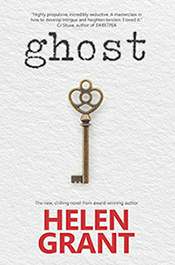Some years ago, I was researching for an article about the demonology of Canon Alberic's Scrap-book, and one of the points I tackled was why the sacristan in that story insists on selling the scrap-book at a fraction of its real value. The idea of selling at a lower price than the purchase sum rang a bell; I immediately thought of Robert Louis Stevenson's excellent story The Bottle Imp, part of his Island Nights' Entertainments.
Stevenson's tale was published shortly before MRJ wrote Canon Alberic's Scrap-book, but even if MRJ did not see it, it was the latest version in a long tradition of bottle imp stories with which MRJ may very well have been familiar. Whilst investigating these, I gathered so much material that in the end I decided to write an article about The Bottle Imp and its antecedents. The article was published in All Hallows 40 in October 2005 and as it has never been republished, I thought I would post it here, with a bibliography and a few small corrections.
I don't believe it breaks much new ground, as some of the influences on Stevenson's Bottle Imp are very well known - Stevenson himself refers to the stage play of the same name by R.B.Peake in his notes on his own story. However, it is a (I hope entertaining) round-up of previous bottle imp tales and may suggest some new reading for anyone interested in the tradition!
‘Tempered in the flames of hell’: an examination of
Robert Louis Stevenson’s The Bottle Imp
It is fairly well known that Robert Louis Stevenson’s tale The Bottle Imp was inspired by an early 19th century stage play of the same title by Richard Brinsley Peake; Stevenson himself owned the debt in his introduction to the story when it first appeared in the Sunday New York Herald in 1891. Others, including J.W. Beach in his 1910 essay on Stevenson’s sources, have traced the bottle imp motif further back to La Motte Fouqué, Grimmelshausen, even to the djinn of the Arabian Nights. I would like to examine these sources – specifically, which elements of earlier versions Stevenson has used, which not, and why - in order to understand what Stevenson contributed to the tradition, and how he made the bottle imp story particularly his own.
Stevenson’s Bottle Imp is set in Hawaii and tells the story of Keawe, a young man who buys a magic bottle containing an imp. The imp will grant any wish of the bottle’s owner, but there are two catches: firstly, whoever dies in possession of the bottle must go straight to hell, and secondly, the bottle must always be sold for a lower price, which means that ultimately the owner will be unable to sell it on. In addition, if the owner is not content with what he has wished for, ill will befall him once he has sold the bottle to someone else. Keawe also discovers that the good fortune brought by the bottle often comes in undesirable ways. In the course of the story, the bottle passes in and out of the possession of Keawe and his wife Kokua, but at the very last is purchased by a foul-mouthed and drunken sailor, who has no fear of the bottle imp’s taking him to hell because he is convinced he is going there anyway; he lurches out of the story with the bottle under his coat, and Keawe and Kokua live happily ever after.
The key element of the story is the danger of wish-fulfilment: Keawe gains his wonderful house through the deaths of his good and beautiful relatives; he wins the love of Kokua but then discovers that he has leprosy, and all his good fortune cannot avail him; he buys the bottle back to wish for his health, and then cannot enjoy it because he lives under the shadow of damnation. Wish-fulfilment stories are amongst the earliest ever told: Greek legend included the tale of Midas, who wished for everything he touched to turn to gold, and then discovered to his dismay that even his food and drink turned to metal when they touched his lips. Tithonus wished for eternal life without wishing for eternal youth, and became so wrinkled and shrunken with age that he turned into a grasshopper. Semele wished to see Zeus in all his divine glory, and was instantly fried to a crisp by his radiance. The Greeks believed that to commit hubris, an act of blasphemous arrogance, would bring down nemesis, retribution, on one’s head, and such stories reflect this; in Christian culture, seeking the fulfilment of one’s wishes through supernatural means leads to the endangerment of one’s soul, hence the story of Faust and the proliferation of other tales of diabolical pacts. Wish-fulfilment is a very dangerous thing in anyone’s book.
As regards specific bottle imp stories, these could ultimately be traced back to the legend of Solomon and the demons. In the very early Christian text The Testament of Solomon (possibly originating as early as the first to third centuries AD), King Solomon imprisons the demon Kunopaston in a phial and seals it with his ring. The djinn of the Arabian Nights appear to be demons imprisoned by Solomon: in The Tale of the Fisherman and the Genie, for example, a poor fisherman discovers a yellow copper bottle bearing King Solomon’s seal; when he opens it, a terrifying djinn bursts forth. In the tale of Aladdin, the ifrit which appears from the lamp is ‘as tall as one of Solomon’s djinn’ and is controlled by whoever wears a magical ring – perhaps the very one used by Solomon. Interestingly, there is some suggestion that possession of the ring and the lamp is spiritually dangerous; Aladdin’s mother is terrified of the djinn and implores Aladdin to throw the ring and the lamp away; she tells him that it is unlawful for anyone to have any dealings with them, and that the Prophet himself had warned against them.
The bottle imp in the form familiar from Stevenson’s story – i.e., a creature which remains imprisoned in a bottle and must be sold for an ever-lower price – can be traced back to German tradition; the earliest version appears to be featured in Grimmelshausen’s Trutz Simplex, published in 1670. Trutz Simplex is the scurrilous memoir of Courasche (Courage), who steals, cheats and sleeps her way through various adventures in a rollicking tale told without a shred of remorse. Courasche is persuaded by an old soldier to buy ‘something in a sealed glass bottle, which didn’t look exactly like a spider but also not exactly like a scorpion.’ She thinks at first that it must be a masterpiece of glasswork, as the thing inside seems to move but can’t possibly be alive since the bottle is sealed. The old soldier tells her that the bottle must always be sold at a lower price, but he neglects to tell her what will happen if she dies in possession of it. Courasche thinks she is buying a valuable piece of art, but is completely unaware of the bottle’s inhabitant or its powers. Later the old soldier tells her that it is a dienender Geist, a spirit that will serve her, and that it will protect her and bring her good fortune. Thinking that there must be some cost to the owner, Courasche presses him to tell her the catch; he reiterates that the bottle must always be sold at a lower price, but refuses to tell her why she should sell it. It is Courasche’s Bohemian foster-mother who informs her that she is in danger of damnation, since she has bought the bottle for two crowns – no-one will buy it from her for one crown, knowing that they cannot sell it on. One interesting feature of Grimmelshausen’s bottle imp is that it seems to provide good luck, protection and good fortune in a general kind of sort of way; Courasche does not make a specific wish for anything. When she finds hidden treasure, it is as the result of an innerliches Einsprechen or inner voice; otherwise she simply notices that all the men she fancies are attracted to her and her business ventures flourish more than anyone else’s. Courasche eventually sells the bottle imp to her associate Springinsfeld as a condition of a settlement she makes him. Springinsfeld inherits the good fortune with the bottle but soon becomes afraid of it and tries to dispose of it. He tries to return it to Courasche, and throws it into the Danube several times, but it always comes back to him, and as he has bought it for one crown he cannot sell it to anyone. At last he destroys the bottle altogether by throwing it into a baker’s oven.
Friedrich Baron De La Motte Fouqué, writing at the beginning of the nineteenth century, further developed the bottle imp theme with his story Das Galgenmännlein (the ‘gallows mannikin’, a kind of homunculus created from the sperm of a hanged man; here the creature in the bottle). In La Motte Fouqué’s tale, a bottle imp is acquired by Reichard, a young merchant, described as ein fröhlicher und kecker Gesell, a lighthearted, saucy young fellow. The story is set at the time of the Thirty Years’ War, as was Trutz Simplex, and it swiftly becomes apparent that the environment of the tale shares much with Grimmelshausen’s: early in the story Reichard falls in with a group of rapacious courtesans, and it is partly to fund further amusements that he purchases the bottle from a Spanish soldier. The soldier tells him that the bottle must always be sold for a lower price, and warns him of the damnation awaiting the ultimate owner. Unlike Grimmelshausen’s creature lurking half-seen within the bottle, La Motte Fouqué’s imp appears as one of the dramatis personae of the story. It continually gloats over Reichard’s future damnation, even singing him a taunting song, and it appears to him in his dreams as a huge black being with bats whizzing around its head, which executes a foul dance and then lies full length upon him, grinning into his face. When Reichard falls ill, it eagerly awaits his demise in order to carry off his soul – La Motte Fouqué’s bottle imp does seem to grant (or deny) specific wishes, since it refuses Reichard’s request for good health – and when at the end of the story Reichard is finally able to rid himself of the bottle, the imp lies at the bottom of it in a depressed and disappointed heap.
The ultimate disposal of the bottle is more satisfactory in Das Galgenmännlein than in Trutz Simplex (in which one might have expected the bottle to reappear after melting, just as it did after being thrown into a river). Reichard sells the bottle to a terrifying giant who is a damned soul constantly slaving at Sisyphean tasks for the devil. Since the giant is already damned, Satan gains nothing by the transaction. Reichard resolves to live a better life, and ends his days as a prosperous merchant, warning his gathered children and grandchildren against diabolical transactions.
No examination of the German bottle imp tradition is complete without mentioning the story Der Geist im Glas in the collected fairy tales of the Brothers Grimm, contemporary with La Motte Fouqué (their Kinder- und Hausmärchen was published in 1812). The Grimms’ tale is much more simply told and owes a debt to The Fisherman and the Genie: a woodcutter’s son finds a bottle in the roots of an oak tree and sees a creature like a frog jumping up and down in it. When he releases the creature, it threatens to kill him, as does the djinn released by the fisherman; in both tales the imp is deceived into returning into the bottle, and in exchange for freedom performs a service to the person who releases him, leading to his eventual enrichment.
Then comes R.B.Peake’s play The Bottle Imp, first staged in 1828. As in Das Galgenmännlein, the imp himself was one of the dramatis personae; he was played by the actor Richard John Smith, dressed in a skin-tight green outfit with spreading wings, and with horns on his head. In this version, the hero of the play, Albert, is able at the end to resell the bottle to Nicola, the necromancer who sold it to him, and Nicola is unable to rid himself of it; the coin with which he has re-purchased the bottle is of the lowest value in the world. Nicola meets a Faustian end. A good description of the play is given in Joseph Warren Beach's article of 1910 (see bibliography and link below); this was the only text which I was unable to obtain at the time of writing this article, so I have not attempted it.
The works I have described above all deal with actual bottle imps; however, comparisons have also been drawn between Stevenson’s Bottle Imp and Balzac’s novel La Peau de Chagrin (The Wild Ass’s Skin). Published in 1831, the book details the adventures of Raphael, a young Parisian who purchases an ass’s skin from a curio shop; the skin possesses a peculiar quality, in that it can grant any wish of its owner, but with every wish it diminishes in size, and the length of the owner’s life is likewise diminished. Raphael initially enjoys the good fortune the skin brings, but gradually becomes obsessed with the shrinking of the skin, and thus also his life expectancy. He is forced to withdraw from public life and live as monotonous a life as possible, since whenever he so much as thinks of wishing for anything, the wish is granted and the skin shrinks. In the final scene, the skin has become a tiny fragment – one wish’s worth – and Raphael is trying desperately not to wish for anything. However, his desire for his mistress Pauline is too great, and he finally expires in her arms.
The parallel between the shrinking ass’s skin and the diminishing price of the bottle imp is clear. However, the bottle imp threatens ultimate damnation: the ass’s skin threatens only physical death. Some have even interpreted La Peau de Chagrin in a non-supernatural way, ie. Raphael is slowly succumbing to obsession and disease, although this would rather seem to be contradicted by the fact that Pauline feels the contraction of the tiny skin in her hand in the final scene. The main interest in comparing Balzac’s La Peau de Chagrin with Stevenson’s Bottle Imp is to observe the authors’ very different treatments of a similar theme: the one a full-length novel set in the gambling dens and salons of Paris, ripe with Baroque details and extravagant descriptions and peppered with exclamation marks, the other concise and understated – there is no melodrama in The Bottle Imp.
I have tried to summarise what one might term the bottle imp heritage prior to Stevenson’s tale; now let us examine what Stevenson himself made of the motif. Stevenson set his tale on the island of Hawaii; of course he lived for part of his life in the South Seas, in an attempt to improve his failing health. The story eventually formed what Stevenson himself considered ‘the centre piece’ of his collection Island Nights’ Entertainments. In his introduction to the story at its first publication in the Sunday New York Herald, he acknowledged the debt to the stage play of the same name, and remarked, ‘…yet I hope I have made it (the story) a new thing. And the fact that the tale has been designed and written for a Polynesian audience may lend it some extraneous interest nearer home.’ The story was in fact subsequently translated into Samoan, and is supposed to have been well-received by Samoan readers; for us the Hawaiian setting is exotic, and lends a fabulous feel to the story. This is further enhanced by the manner language Stevenson uses: for example, he tells us that Kokua ‘had the good word always’; elsewhere, the hero Keawe cries, ‘…it is for you, O Kokua! that I pour my lamentations!’ The effect is rather that of an English translation of a text written in a foreign language; it adds colour to the story, and also credibility: it is easier to imagine magic occurring somewhere far away and exotic, whereas the effect would be diminished in a homely environment. The fabulous quality of the story is further enhanced by the descriptions, for example of the house Keawe visits which has steps which shine like silver and windows which are bright like diamonds: these are fairytale qualities, reminiscent of the sparkling silver-leaved trees in the Grimms’ tale of the twelve dancing princesses, or the wonderful clothes in the tale of Allerleirau (the patchwork skin), golden as the sun and silvery as the moon.
Stevenson’s hero, Keawe, differs greatly from the heroes of Grimmelshausen, La Motte Fouqué, and Balzac. Courasche is an unashamed strumpet and vagabond, Reichard is a loose-liver, Raphael a gambler. Keawe is their opposite: when, for example, he discovers that he has leprosy, he laments that he may not now marry Kokua, but Stevenson comments, ‘…he might have wed Kokua even as he was, and many would have done, because they have the souls of pigs, but Keawe loved the maid manfully, and he would do her no hurt and bring her in no danger.’ Courasche would have had no such scruples, and indeed boasts of spreading the pox to a former lover. Of course, the greater part of Victoria’s reign lies between Stevenson and the earlier versions of the bottle imp story which I have described, and one would not expect to find his hero a hard-drinking, gambling and whoring man. But more importantly than that, Keawe is a hero for whom we can really care; furthermore, he is a kind of Everyman: he is not rich, but he is active; he is educated, but not showily – ‘he could read and write like a schoolmaster’; and he has practical manly skills – ‘he was a first-rate mariner besides.’ He is not so elevated in life that we cannot imagine ourselves in his place; nor is he a rascal like Courasche, whose antics we might observe with enjoyment but never dare to try ourselves; nor is he a bad man, whose damnation would be his just reward (compare him with the coarse boatswain who buys the bottle at the end of the story: who spares a thought for his welfare?). We can sympathise with Keawe; we can think, ‘How terrible if that happened to me.’
What also marks out Stevenson’s story from other tales in the bottle imp tradition is its restraint; the things which Stevenson does not show, or does not tell us in blunt words. La Motte Fouqué’s imp is out of its bottle whenever it can be, grinning into Reichard’s face and pressing its hairy body up against him. Peake’s imp flitted about in wings and horns, taunting Nicola with his doom. Stevenson’s imp is seen by Keawe and his friend Lopaka, slipping out and back into the bottle ‘swift as a lizard’; but we do not see the imp. Its appearance is such that the two friends sit, as though turned to stone, until night falls; it is mot until then that either of them can think how to react, and this is enough to impress us with the imp’s horror. From the outside of the bottle one can only see something which ‘obscurely moved, like a shadow and a fire’, almost an abstract thing, not the scorpion- or spider-like creature of Trutz Simplex or the anthropomorphic demon of Das Galgenmännlein. Hell itself is represented by images of flames and smoke, coals and cinders, a bottomless pit- There are no frolicking demons with pitchforks to bring the story into the realm of melodrama.
It is perhaps unfair to compare Stevenson’s treatment of his characters’ behaviour with that of Balzac in La Peau de Chagrin, since the two were writing within different canons; nevertheless, it is interesting to do so. Raphael’s last scene with Pauline is a wild drama of threats, passion, and physical struggle; he repulses her, then pursues her, screaming that he wants to die in her arms; Pauline, half-naked and writhing, attempts suicide to save him; Raphael batters down the door and embraces her, at the last sinking his teeth into her breast in a fit of passion. The overall effect for the reader is one of high drama and physical horror.
Stevenson’s characters walk a tightrope over a bottomless pit of fire, yet they are collected enough to keep up a pretence even to each other. Keawe does not at first tell Kokua why he is unhappy after their marriage; Kokua does not tell him that she has purchased the bottle through an intermediary to save him, and he only discovers this when he comes upon her secretly at night-time and finds her wringing her hands over the bottle – not screaming, crying or attempting self-injury, but simply brooding over it. Keawe feels the ground heaving and the house spinning around him, and his soul is bitter with despair, but he never raves like a maniac, instead maintaining a calm appearance before Kokua; he maintains his honour even to the foul-mouthed boatswain, whom he tries to dissuade from keeping the bottle. The effect of this restraint in the narrative is to heighten the sense of long drawn-out tension, the full horror of the Faustian pact. There is no need to rant and rage now; damnation is not upon our hero yet. But it is coming, slowly and surely, be it ever so far in the future. It is always there, underlying the actions and words of every moment that passes. If Balzac’s tale s a fevered nightmare, Stevenson’s is a waking terror.
Stevenson’s resolution of the dilemma at the end of The Bottle Imp is highly satisfactory. In creating a hero as sympathetic as Keawe, he could not then consign him to perdition. Grimmelshausen’s idea of destroying the bottle through fire is, to my mind, unconvincing; a bottle forged in the flames of hell and containing a denizen thereof is unlikely to be so simply melted in an oven. It has already bounced back from being thrown into a fast-flowing river and dashed to the ground. La Motte Fouqué prefigures Stevenson’s idea of transferring the bottle to someone whose soul is already damned, but his giant slaving away for the devil is a superhuman figure, a grotesque who dyes his clothing with his own blood. It is only through this supernatural agency that Reichard can rid himself of the bottle. Stevenson uses no such dues ex machina; instead the bottle is passed on, as it always should be, by selling at a lower price to another human soul. The foul-mouthed sailor who buys it is, by his own estimation, destined for perdition anyway, and he staggers out of the story with the bottle in his pocket to meet his end off-stage, the drama left to our imagination, as is the appearance of the imp itself. Keawe, who has proved his moral integrity by being prepared to buy the bottle back even from such a creature as the boatswain, is free to enjoy his wife and home. Chastened by his experience, he is destined to keep his good fortune, for he will never be discontented with it.
That is the end of Keawe’s story, but not of the bottle imp tradition, which has life in it yet. For example, the American TV series The Twilight Zone featured a bottle imp type story titled The Man in the Bottle. And in Germany, where there is a long tradition of Flaschenteufel stories, it is possible to buy toy bottle imps, tiny creatures made of blown glass in a bottle of water with a flexible seal – the seal can be pressed or released to change the water pressure and make the ‘bottle imp’ move. There is even a card game entitled Flaschenteufel, which requires that the ‘bottle imp’ be passed to whoever plays a card lower than, and closest to, the bottle imp’s value. It seems that the bottle imp theme, like the creature in Stevenson’s story, continues to be handed on.
Bibliography:
Island Nights' Entertainments by Robert Louis Stevenson (on Project Gutenberg)
The Sources of Stevenson's The Bottle Imp by Joseph Warren Beach (1910)
Tusitala and his Polish reader from No Island Is An Island by Carlo Ginzburg (2000)
The Testament of Solomon, English translation by F.C.Conybeare (1898)
La Peau de Chagrin by Honoré de Balzac, French edition published by Le Livre de Poche
NB If you wish to read this in translation, an English version The Wild Ass's Skin, translated by Herbert J. Hunt, is available from Penguin Classics.
Trutz Simplex von Hans Jakob Christoffel von Grimmelshausen, online text at Zeno.org
NB If you wish to read this in translation, an English version The Life of Courage, translated by Mike Mitchell, is available from Dedalus European Classics.
Das Galgenmännlein from Rittergeschichten und Gespenstersagen by Friedrich De La Motte Fouqué, German edition (2000) from Buchendorfer Verlag.
Märchen der Brüder Grimm, German edition with illustrations by Nikolaus Heidelbach, published by Beltz & Gelberg.
Above: a bottle imp yesterday.
Post script: My Ghost Stories of Innerpeffray includes a story, Nick's Tale, that is a twist on the bottle imp tradition. The complete set of three stories will shortly be appearing in chapbook format, available from the Library of Innerpeffray. I will post details on my blog as soon as the chapbooks are on sale.










There are many benefits to be enjoyed by storing water in copper vessels before drinking. Ancient Ayurveda medical texts have recommended storing water in copper. At this time when the world is riddled with pollution, our countrymen are using high potency tablets even for minor problems which is spreading poison in their bodies.
ReplyDeleteNice blog thnax for posting.
ReplyDeleteIndia Metal Corporation also dealing with all kind of scrap such as ferrous and non ferrous, aluminum scrap, plastic scrap, copper scrap, paper and waste scrap etc in pune.
Scrap buyer in Pune
Copper Brass Scrap Buyer in Pune
Aluminium Scrap Buyer in Pune
Steel Scrap Buyer in Pune
Glass Scrap Buyer in Pune
Iron M.S. Scrap Buyer in Pune
Metal Ferrous Scrap in dealer in Pune